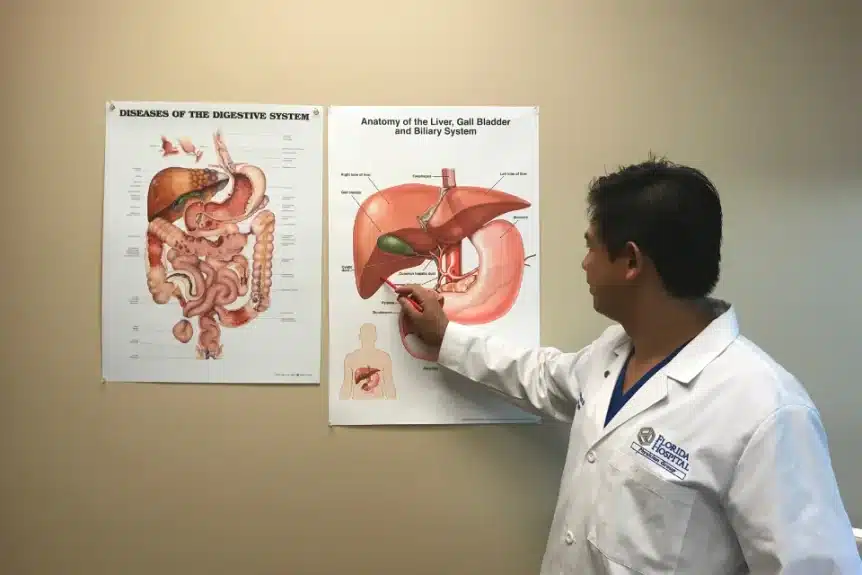
Scientific Liver Surgery Lecture During the Caribbean Chapter of Americas Hepatopancreatobiliary Surgery Association
Recently, Dr. Iswanto Sucandy was invited to come to the Annual Meeting of the Americas Hepatopancreatobiliary Surgery Association (AHPBA) in Barbados to join many expert surgeons from around the world sharing his expertise in robotic liver surgery. This annual meeting was attended by expert hepatobiliary and liver transplant surgeons from Argentina, Australia, Manchester, the UK, New York, Calgary Canada, and other countries. The former president of AHPBA Dr. Elijah Dixon was also present in this meeting.
Dr. Sucandy was invited by the president of the Caribbean Chapter of AHPBA Dr. Shamir Cawich to give a lecture on the “Evolution of Treatment for Stage-4 Colorectal Liver Metastasis”. In this very important discussion, Dr. Sucandy shared the history of colorectal liver metastatic surgery and how it has changed in the last 40 years. The treatment paradigm has dramatically evolved based on scientific discoveries of better/more effective chemotherapeutic agents, improved outcomes of liver surgery, availability of multimodal treatments, and better perioperative care.
Dr. Sucandy explained the natural history of colorectal liver metastasis, a topic that was studied in the early 1970’s. At that time, major institutions started to offer minor open liver resection for single colorectal liver metastasis. After documenting the clinical benefits and improvement in overall survival, the open liver surgery for this disease gradually expanded to include major liver resections, multifocal disease, concomitant lung and liver metastasis, and repeat resection for recurrent liver tumors. At this time after 40 years of clinical evolution, liver resection for colorectal liver metastasis is performed aggressively while maintaining adequate future liver remnant volume after surgery. Dr. Sucandy and his team routinely perform 3-D liver volume measurements prior to any major liver resections to avoid the incidence of postoperative liver failure with less than 20% of liver volume remaining. An advanced software by Fujifilm Inc. is used to reconstruct the liver anatomy and to measure diseased liver volume as well as the healthy /uninvolved liver segments. This way, the volume of the liver to be resected and preserved can be accurately measured. This is a process that must be undertaken to ensure the safety of the patient undergoing major or extended liver resections.
Today, with the advent of minimally invasive surgery, liver resections for colorectal metastasis have further evolved to include robotic liver surgery. The open liver resection had become a routine operation in our center with minimal complications, therefore we can expand the technology to now offer robotic liver resection even for major hepatectomy (removal of more than 3 consecutive liver segments). Since 2016, Dr Sucandy continuously perfected the techniques of robotic liver resections, producing excellent outcomes despite the increasing case complexity. When we started in late 2016, our robotic liver resections were mainly non-anatomical small resections. However, within a short time of 1 year, our robotic liver resections expanded to include major and extended liver resections. Three years ago, we started to perform robotic vascular resection and reconstruction for tumor invasions into the adjacent vascular wall. This is a major step in robotic liver surgery since vascular resection is traditionally considered a contraindication for minimally invasive surgery. 99% of surgeons will utilize an open approach due to a lack of familiarity and expertise in advanced robotic surgery. Similarly, liver surgery requiring concomitant biliary resection and reconstruction is now routinely performed using the robotic approach in our center in Tampa. We have completed our learning curve for robotic major liver resections before undertaking this very complex operation. Not many centers in the United States are offering this kind of resections using the robotic approach. Dr. Sucandy and his team have also published several scientific articles in prestigious surgical oncology journals regarding the techniques and outcomes of this operation. This work is leading the development of robotic complex hepatobiliary surgery in the World. Dr Sucandy plans to host the Caribbean hepatobiliary surgeons to visit our robotic surgery center in Tampa to improve the care of patients in the Caribbean islands, who are still faced with lack of health care resources.

